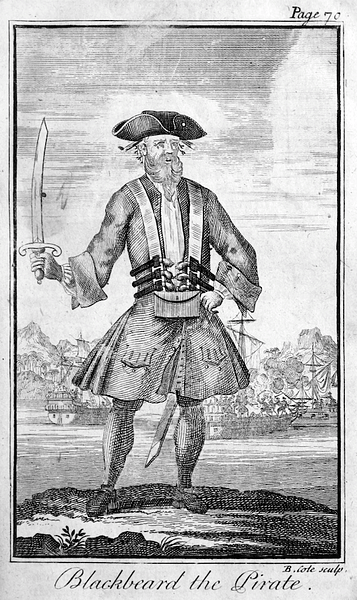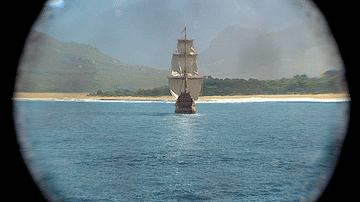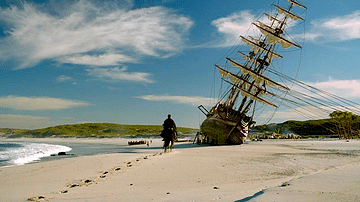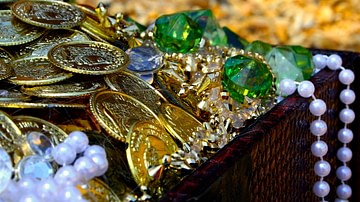Pirates in the so-called Golden Age of Piracy (1690-1740) used all manner of weapons to attack ships and relieve them of their precious cargoes. Heavy cannons, muskets, pistols, cutlasses, and grenades were just some of the weapons pirates employed to wreak havoc on the High Seas. Besides all of these, perhaps the best pirate weapon of all was the black flag they raised, like a Jolly Roger, or an all-red flag, which meant a vessel should surrender immediately or face dire consequences.
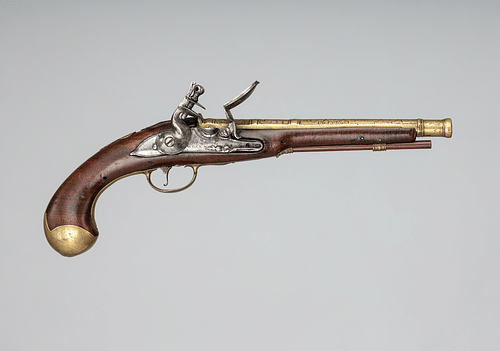
Cannons
Firing a broadside of heavy cannons allowed a pirate vessel to attack a ship from distance, but it must be remembered that pirates often wanted to take over the vessel or sell it for profit and so filling it with holes was hardly a wise move. In addition, pirate targets were almost always unarmed or lightly-armed merchant vessels. Neither were cannons really needed for defence since if an enemy ship or a pursuing naval vessel was too heavily armed, the pirates avoided it or fled in their (usually) smaller and quicker ship. Very few pirate vessels could match even the lowest-rated naval vessel in either firepower or the skills needed for sustained and accurate cannon fire.
Cannons had a smooth bore in the Golden Age and were fired by ramming an iron ball down the muzzle, pouring gunpowder into a hole in the breach, and lighting it using a slow match (a length of rope which had been chemically treated to burn slowly). Cannons on a pirate ship would have been taken as booty from captured vessels and so they varied in size and power, even on the same ship. The largest cannons might have a barrel up to 12 feet (3.6 m) long and be capable of firing a ball weighing 68 pounds (over 30 kg). However, very few ships had the strength to carry such monsters, and pirates preferred their ships to be fast and sleek. A sloop, the most commonly used vessel type, would have carried only a handful of cannons, and these were usually capable of firing 8- or 12-pound (3.5 or 5.5 kg) cannonballs.
There were variations of cannonball besides the standard solid type. A hollow ball could be fired further or it could be filled with gunpowder and have a fuse fitted so that it exploded on arrival. A ball could be heated so that when it embedded itself in the hull of an enemy ship it might start a fire in the surrounding timber or the pitch set between planks. Canisters full of small metal pieces - grapeshot - were fired to maim men and cut down rigging. For the same reasons, iron bars or chain shots (two balls connected by a short chain) were fired. By ripping apart rigging and hopefully breaking a few spars, it became extremely difficult for the target vessel to sail off over the horizon.

The tremendous recoil made by the cannon was cushioned by having it rest on a wheeled platform tied within a mechanism of ropes and blocks. It could take up to 10 minutes to reload a cannon and so considering the difficulty of keeping a moving ship on target (and that the attacker was also moving), both surprise and making sure the first shot counted were often essential to success. Cannons were not precision instruments, and variations in ball size, elevation, distance to the target, movement of the ships, and the varying strength of gunpowder made firing them accurately an elusive challenge. For this reason, captains usually waited until they were within 500 feet (150 m) or closer to an enemy vessel before firing a broadside.
In the 17th century, a cannonball could be fired with enough force to pierce a ship’s hull. As mentioned, though, this defeated the object of trying to capture the ship and might seriously endanger its precious cargo if the vessel sank. With luck, a single shot across the bow of a target was enough to bring a peaceful surrender.
Swivel cannons, small brass or bronze cannons fixed to various parts of the upper decks but which could be turned to fire in any direction, were used to sweep the decks clear of the enemy and to repel boarders. With two handles to aim them, the weapon was highly effective and became known as a 'murderer'. They were light enough to be moved from one side of the ship to another in pre-prepared slots and could even be used in small boats.
Grenades
Getting a little closer to an enemy vessel, the next weapon to be employed could be grenades, often called fireballs or powder flasks. These were made from glass bottles filled with gunpowder and a quantity of lead shot or random metal pieces. A slow match like those in guns was put into the neck of the bottle or tied around it so that when arriving at its destination and smashing, flame hit powder and the whole thing exploded. Grenades known as stinkpots might also be filled with substances like sulphur to intoxicate an enemy crew.
Handheld Guns
Pirates had several portable gunpowder weapons to choose from which they could use when boarding target vessels. All of them had the disadvantage that they could only fire one shot and then had to be reloaded, which took time that often was not available in the heat of battle. In addition, gunpowder weapons needed dry weather to work best, they were often unreliable and misfired or exploded, and they were not particularly accurate. Some pirates compensated for these defects by carrying several weapons at once, the most famous of these was Edward Teach, aka Blackbeard (d. 1718), who was said to have bristled with six pistols hung from sashes across his torso.
The musket, in wide use from the mid-16th century, fired a lead ball loaded through the muzzle and rammed down on top of a quantity of gunpowder. It was fired by applying a lighted slow match to the powder. The match was placed at one end of a short metal lever which had an S-shape. When the lever was pulled forward, it applied the match to the powder via a small hole in the breech. By the 1690s, this matchlock system had been replaced by the flintlock mechanism. A flintlock weapon had a trigger which, when pulled, dragged a small vice called a cock down on a piece of flint to create the spark that would light the gunpowder. Muskets fired a ball of up to two ounces (55 g) in weight. A musket could be fired with reasonable accuracy by an experienced shot and so they were often useful for picking off choice targets like the captain of a vessel under attack, a kill which then might bring the surrender of the entire crew.
Given the time needed to reload a musket, an experienced pirate would likely pre-prepare a number of all-in-one charges before an attack. These charges consisted of a wad, gunpowder, and ball or shot and were kept in a bandolier of leather pouches worn across the chest. It was common in the 17th century to carry 12, and these were nicknamed 'the Apostles'. The musket evolved in the 1620s from the first heavy examples that required a pole to rest the four-foot (120-cm) barrel on to shorter versions. Pirates often sawed the end off both the barrel and the stock to make a musket more convenient to wield in close-fighting situations.
The arquebus was another 16th-century firearm with a smooth bore barrel lit by a matchlock. It was distinctive from the musket for its short barrel and curved stock. The gun gave a vicious recoil, and for that reason, early versions had a hook to attach the weapon to a fixed object like a wall when firing. The arquebus was superseded by the blunderbuss in the 17th century, a sort of handheld cannon which was a cross between a pistol and a musket in terms of barrel length. The blunderbuss often had an expanding barrel, and it could be stuffed will all manner of lethal heavy metal like shots, balls, and lead slugs. It was a particularly effective weapon of defence against enemies of superior numbers since it scattered its lethal load over a wide area. The disadvantage was the tremendous kick of a blunderbuss, easily capable of breaking a rib or knocking the holder down if not held correctly.
Perhaps the favourite handheld gunpowder weapon of pirates was the pistol, in use from around 1530. Requiring more skill to fire accurately, they had the advantage of not impeding one’s movements when fighting in the cramped and unstable conditions of a ship at sea. Matchlock pistols needed to be held in both hands when fired, only with the flintlock version available from around 1600, did pistols become a really useful weapon for pirates. With a single barrel up to one foot (30 cm) in length, a pistol typically fired a surprisingly heavy ball. There were some double-barrelled pistols, but these were expensive and rare. Since a pistol could really only be fired once in the heat of action, having a brace or two hanging on one’s person was a distinct advantage. Pirates often tied their pistols to a belt using linen or silk ties so that, once fired, such a valuable piece of equipment would not be lost.
Firearm weapons were entirely the concern of the individual on pirate ships. There was no central armoury like in naval vessels and so a pirate would only really have possessed a firearm if he had taken it from a captive or he had the means to purchase one from a trader in such a place as Port Royal, Jamaica. The rarity of the pistol and the potential to make it highly ornate with engraved silver additions or brass scrollwork meant it also became a weapon of prestige, something which, conspicuously tucked into a belt, a captain could use to display his success to a crew or to fellow pirates on shore in a haven. Crew members were usually obliged by the ship’s articles they had signed to keep their weapons clean and ready for action at all times.
Cutlasses
Considering some of the drawbacks of gunpowder weapons, it is perhaps not surprising that most pirates favoured the speed and thrust of a sword blade. Thin duelling-type swords were not in use until the 17th century and then only by the nobility. Rather, pirates used a heavy cutlass or sabre which had a sharpened point and a sharp single edge of the blade. These swords were designed to quickly cut and slash an opponent rather than dither about with intricate swordplay. The cutlass had a slightly curved blade, and the hand was well protected by a half-circle guard or cage. The blade could be up to 3 feet (90 cm) in length. As a cutlass blade was thick and heavy, it could be used for other useful tasks such as cutting rigging in an emergency, felling trees, and opening coconuts.
Other Weapons
Most pirates were not wealthy by definition, and all of the above weapons so far mentioned were not easy to come by for an ordinary member of a pirate crew. For this reason, a common weapon was a simple short club, often merely a belaying pin, normally used to hold rigging in place. Other weapons used included pikes, axes, spears, machetes, throwing knives, and long knives. The long pike or halberd was essential in case the enemy was equipped with them and so many pirate ships carried an arsenal of these in a handy rack on deck. Axes often had a blade on one side and a hammer on the other, very useful for breaking down cabin doors or to use as steps when several axes had been implanted into the side of a ship.
Pirates were, then, practical fighters, and they used any weapon at all that helped them take over a ship with as little fuss as possible. Further, if their reputation, appearance, and flag all did their jobs, next to none of these weapons would have needed to taste any blood.

